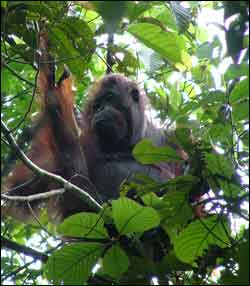Genetic Study Shows Decline of Orangutan Population Due to Humans

Ongoing deforestation and palm oil plantations leave no room for the orang-utan. (Photo: Jamil Sinyor-KOCP)
Genetic study shows humans have pushed orangutans to the brink of extinction
A new study published in the open-access journal PLoS Biology shows strong genetic evidence of a catastrophic collapse in orangutan populations living in the fragmented forests of the Kinabatangan Wildlife Sanctuary in Sabah, Malaysia. Benoit Goossens, Lounès Chikhi, Michael Bruford, and their colleagues report that the collapse occurred within the past hundred years, and most likely within the past decades—coinciding with massive deforestation, which began in the region in the 1890s and accelerated in the 1950s and 1970s.
“This is the first time that a recent and alarming decline of a great ape population—brought about by man—has been demonstrated, dated, and quantified using genetic information,” says Goossens, a wildlife geneticist at Cardiff University who conducted the genetic study. “Developing effective conservation and recovery programs depends on determining when the decline of a population began, its trajectory, and the original population size.”
For their study, the researchers collected hair from tree nests and feces found under nests or near orangutans encountered along the Kinabatangan River. Two hundred orangutans were identified using genetic markers called microsatellites. “We used the DNA information to simulate population history and detect evidence of a population decline,” Goossens explains.
“The genetic study shows that there is a high risk of extinction of the orangutan in Sabah in the near future if this decline goes on unabated,” says Marc Ancrenaz, who also participated in the study. “The major threat to the long-term survival of orangutans in Sabah is linked with oil palm plantation development and forest destruction. Illegal killing also contributes to this decline.”
Sixty percent of orangutans found in Sabah are living outside the network of protected areas. “The largest population of the East Bornean orangutan subspecies existing on Earth occurs in the forests of the Sabah Foundation concession, with a population of about 5,000 individuals,” says Laurentius Ambu, Sabah Wildlife Department’s Deputy Director. Most of these forests are exploited for timber under natural forest management, but orangutans cannot survive in industrial tree plantations.
“This population will disappear forever if these forests are converted to oil-palm agriculture,” Ambu says. “The results of our genetic study underscore the need to act now to protect the long-term survival of the species. The animals still show enough genetic diversity to stabilize, if immediate steps are taken to reconnect remnant forest patches and halt further deforestation.”
Media Contact
All latest news from the category: Life Sciences and Chemistry
Articles and reports from the Life Sciences and chemistry area deal with applied and basic research into modern biology, chemistry and human medicine.
Valuable information can be found on a range of life sciences fields including bacteriology, biochemistry, bionics, bioinformatics, biophysics, biotechnology, genetics, geobotany, human biology, marine biology, microbiology, molecular biology, cellular biology, zoology, bioinorganic chemistry, microchemistry and environmental chemistry.
Newest articles

Silicon Carbide Innovation Alliance to drive industrial-scale semiconductor work
Known for its ability to withstand extreme environments and high voltages, silicon carbide (SiC) is a semiconducting material made up of silicon and carbon atoms arranged into crystals that is…

New SPECT/CT technique shows impressive biomarker identification
…offers increased access for prostate cancer patients. A novel SPECT/CT acquisition method can accurately detect radiopharmaceutical biodistribution in a convenient manner for prostate cancer patients, opening the door for more…

How 3D printers can give robots a soft touch
Soft skin coverings and touch sensors have emerged as a promising feature for robots that are both safer and more intuitive for human interaction, but they are expensive and difficult…





















